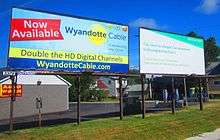Wyandotte Municipal Services
|
"A community-owned, consumer-focused organization providing competitive services in an efficient, reliable, economically and environmentally responsible manner"[1] | |
| Non-Profit, Consumer-Owned | |
| Industry | Electric, Water, Telecommunications |
| Founded | 1889 in Wyandotte, Michigan, USA |
| Headquarters | Wyandotte, Michigan, USA |
Key people |
Roderick J. Lesko[2] General Manager |
| Products | Electric Service, Broadband Internet, VoIP, Water Services |
| Website | www.wyan.org |
Wyandotte Municipal Services is a not-for-profit service provider located in Wyandotte, Michigan. The services that WMS provides are electric, cable telecommunications, and water supply and treatment to the City of Wyandotte. WMS was created by local residents more than 100 years ago. The City of Wyandotte, Michigan is the only community to own and operate its own power plant, water treatment plant, and cable TV headend.
Electric Services
In December 1889, the Wyandotte Electric Light Company initially provided street lighting and electric service for the city.[3] At this time, the company was a for-profit entity. After a few years, residents voted to create a municipal electric utility.[4]
Currently, WMS is one of the 41 public power systems in Michigan and one of 2,000 public power systems in the United States. The electric system alone generates $22.2 million in revenues, and sold 282 million kilowatt-hours in the year 2001. It is a member of the American Municipal Power-Ohio.[5]
Peak electric demands, which occur during the summer, span from 65 to 70 megawatts. The electric system has three sources of supply to provide reliable, and most economical service:
- A 70-megawatt municipal power plant
- A 28-megawatt interconnection with Detroit Edison's 40,000-volt transmission system
- A 98-megawatt interconnection with Detroit Edison's 120,000-volt transmission system
Wyandotte Municipal Power Plant
The Wyandotte municipal power plant has three boilers and four generators. Types of fuels that are consumed are coal, natural gas and tire derived fuel (TDF). TDF is more efficient than coal, has a higher BTU value than coal, and is about half the price of coal. It produces nearly the same emissions. 95% of ash produced at the power plant becomes recycled materials like cement, and is used in steel production. 13,000 tons of TDF (which is the equivalent of 2.6 million tires) were used at the power plant in 2001.
Wyandotte Municipal Electric Distribution System
The electric distribution system is separate from that of the surrounding areas. WMS owns its own lines, which in turn, are connected to the municipal power plant. They consist of 12.5 miles (20.1 km) of 69,000-volt transmission lines and 75.3 miles (121.2 km) of 13,200-volt and 4,800-volt distribution lines. Also, without additional charge, WMS maintains street lighting in the community.
Cable Television Services

In 1981, local residents created the Wyandotte Municipal Telecommunications utility to provide cable television. Cable television was installed in the first Wyandotte homes in January 1983. Among the original channels carried on the Wyandotte system included most of the local Detroit-Windsor, Ontario broadcast stations, plus Toledo, Ohio PBS station WGTE-TV (still carried to this date) and then-superstations WOR-TV out of New York City and WTBS out of Atlanta.[6] High-speed Internet service was first made available in 2001. A total of 9,972 cable TV customers, and 1,815 high-speed internet customers. The telecommunications system alone generates $4.4 million annually.[7]
The system consists of:
- Over 275 digital channels
- Digital pay-per-view selections
- Two Public, educational, and government access (PEG) cable TV channels without additional charge
The system contributes five percent of gross revenue to the city’s general fund. The system is up-to-date. It was rebuilt from the headend to the consumer in 1998. The system converted to digital in 2014, coinciding with a rebranding into Wyandotte Cable. Again, WMS also owns the lines and they are separate from surrounding communities. It consists of:
- 25-miles of fiber optic lines
- 72-miles of coaxial cable
The system has its benefits over the other communities, both in monthly service charges and in customer service.
Water Services
Local residents also created the Wyandotte municipal water utility for fire protection, and also a safe source of drinking water. The utility has 11,142 consumers, and $2.4 million alone in revenue. 1.86 billion US gallons (7,000,000 m3) of water were used in 2001.
Wyandotte Municipal Water Treatment Plant
Wyandotte is the only downriver community that owns and operates a water treatment plant. The Wyandotte municipal water treatment plant can produce up to 15 million US gallons (57,000 m3) of water per day.[8] The community's water source is the Detroit River, and the treatment process consists of:
- Screen or remove debris
- Add alum for coagulation of suspended particles
- Add chlorine for disinfection
- Add phosphate for stabilization
- Remove all suspended particles through filtration
- Add fluoride to prevent tooth decay
Wyandotte Municipal Water Distribution System
The municipal water system is again separate then that of surrounding areas. The system consists of:
- 110 miles (180 km) of water mains ranging from 4 inches (100 mm) to 30 inches (760 mm) in diameter.
- 850 fire hydrants
- 500,000-US-gallon (1,900,000 L) water tower located in the south end of town
- 4.5 million US gallons (17,000 m3) of storage at ground level for peak demand and fire fighting.
